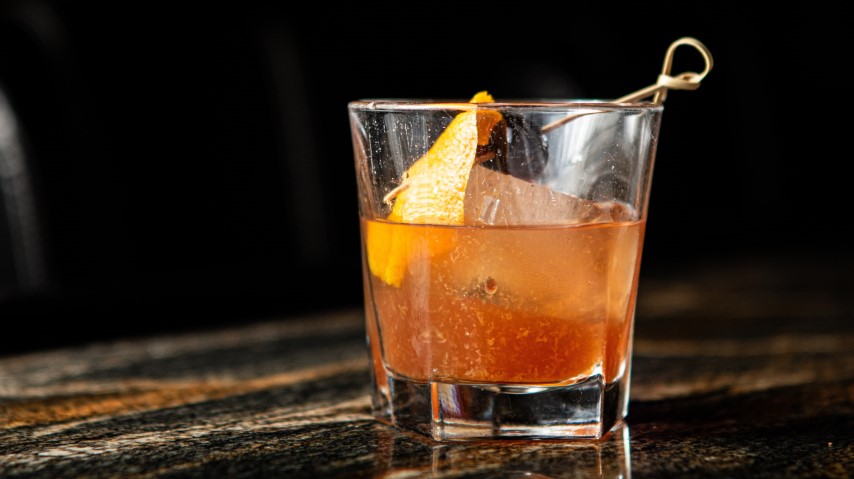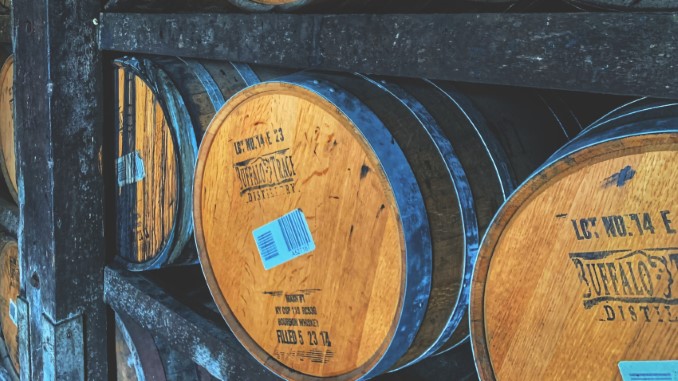Bourbon Bros, Please Consider Diversifying Your Drinking
Photos via Unsplash, Phil Cruz, Josh Collesano Drink Features whiskey
I love bourbon. I love consuming it neat, or as the base of bourbon cocktails. I love to cook with it, or bake with it. I love to visit the distilleries that produce it. I love to sample new bourbon brands, and I’m lucky enough to be able to write reviews, lists and features on bourbon for this very publication. It’s the quintessential American spirit, and I love learning more about it.
However. I also love drinking and dissecting rye whiskey. And malt whiskey. And rum. And gin. And tequila. And tiki cocktails. And a dizzying array of other spirits, liqueurs and cordials. For me, bourbon is simply one star in a constellation of amazing spirits. And the weird thing is, this actually seems to make me something of an oddity among the committed breed of modern bourbon geek I find myself surrounded by in 2022. It’s an observation that illustrates a subculture that has become frustratingly myopic in recent years, closed off from the wider world of alcohol experience, instead revolving around a small circle of heavily hyped bourbon brands from a tiny handful of influential distilleries. More and more, it seems that every bourbon geek I meet has a vast, incredibly deep collection of expensive, sought-after bourbon bottles … and next to no experience with the countless other spirits they might enjoy just as much, if they’d only give them a chance. This is the very essence of hype-driven modern bourbon culture, and it only seems to be getting worse as sticker prices soar.
Before I dive further into this issue—and because I have no doubt that dozens of Twitter accounts are already firing up their “Why can’t you just let people like what they like?!?” responses—allow me to state for the record that I’m really just trying to help here. The truth of the matter is that there’s an incredibly varied, refreshing, novel and alluring world of spirits out there, and all too many bourbon-focused drinkers are missing out on it entirely. I simply don’t want to deprive anyone of the superb flavor found in a wide variety of spirits, and the pleasure in the experience of broadening your horizons. I’m not trying to tell anyone “don’t drink bourbon.” I’m merely suggesting that applying the same curiosity to other corners of the alcohol world can be deeply rewarding, and even deepen one’s appreciation of bourbon at the same time. It’s true!
 Now would be an excellent time to mix yourself a cocktail for this read.
Now would be an excellent time to mix yourself a cocktail for this read.
The Source of Bourbon Fixation
The first and most obvious question is “Why is bourbon fixation so rampant in the U.S. in the first place?” Why does this market have so many drinkers who are desperately hunting for $200 bottles of bourbon, but simultaneously have no interest in or knowledge about other spirits? How does such a zeitgeist develop?
I suspect that the roots of this myopia have to do with the trickle-down effects of any “rarity” hype cycle, with modern bourbon culture being in many respects the ultimate result of the mania that really began with the deification of Buffalo Trace’s Pappy Van Winkle in the 2000s. As Pappy went from being merely a bottle of whiskey, to a status symbol for elite wall street bankers and well-connected suburban dads, the trickle-down process began and hype spread to other brands via osmosis. First it was the likes of the Buffalo Trace Antique Collection, which shared proximity to Pappy as an annual limited release from the same distillery. Then it was the W.L. Weller line of more affordable wheated bourbons, which shared Pappy’s recipe but not its age statements. But before long, it was any semi-special release from Buffalo Trace … and then practically any Buffalo Trace product of any kind, even flagship bottles that had sat on the bottom shelves of whiskey aisles for decades. Consumers new to the whiskey scene, meanwhile, witness this clamor for bourbon, and feel like they must be missing out. When they seek out opinions online, they primarily see nothing but chatter about a handful of specific brands, and the cycle of hype becomes self-sustaining as the new bourbon recruits focus on searching out ONLY those specific brands that they’ve been told represent “the good stuff.” The blinders are now on.
As that chain reaction plays out, a few years pass and you now have lines of bourbon collectors standing outside liquor stores on any day that anything even remotely “rare” is expected to arrive, many of whom will snap a photo of the bottle in their car (inevitably cradled in their crotch) and then immediately post it to a collector’s Facebook group with a caption like “is this any good?” This is of course an attempt to fish for DMs with offers on the bottle, which can then be traded or sold at a brisk 300-500% markup. This is where we are today; a bourbon scene where even year-round bottles often experience rampant price gouging from secondary sellers and increasingly from the retailers themselves, who jack up their prices after reasoning that if their customers are going to profit off the secondary market, they might as well join them.
This phenomenon is perhaps most clearly seen via social media, and especially bourbon appreciation or “hunting” Facebook pages that exist on national or state levels. In these places, which are the domain of most burgeoning whiskey geeks, it often seems that every other post is a photo with some twist on the following caption: “I’ve been in the bourbon game for a few months, here’s my collection.” This is paired with an image of shelves full of every Buffalo Trace brand they were able to lay their hands on, with a paltry remainder of a few high-priced bourbon bottles from other distilleries. Posts of this nature illustrate a generation of whiskey consumers who are focusing their attention exclusively on acquiring whatever the groupthink acknowledges will give them street cred and online praise, rather than drinkers who have explored even a fraction of the breadth of a single whiskey category, let alone many spirits categories. Being “well-rounded” is rarely seen as a virtue in this kind of scene—the only measuring stick is how many rare bourbon bottles one can acquire, and many “newbies” are thus acquiring extremely niche knowledge in one field, while lacking even basic knowledge in another.
 A textbook example of the “look at all the Buffalo Trace I bought and then arranged on my oven for some reason” Facebook post.
A textbook example of the “look at all the Buffalo Trace I bought and then arranged on my oven for some reason” Facebook post.
As someone who first began writing about spirits through the lens of craft beer in the 2010s, seeing this kind of hype cycle play out actually felt oddly familiar for me. After all, I’ve seen the same phenomenon occur over the years in other sectors, including in beer. People lining up for hours in the cold, hoping to have a chance at a bottle of bourbon reminds me in particular of the heyday that a brewery like Three Floyds experienced in the Chicago area in the mid-2010s, when you would regularly hear of beer geeks going from store to store, chasing delivery trucks in an effort to hunt and hoard beers like the cult pale ale/IPA known as Zombie Dust—even if they didn’t actually know anything about the beer! I recall one conversation in particular with a package store owner, who expressed frustration at the people who would come in and ask for Zombie Dust, without being interested in any of the other, similar beers on the shelves. When he told one person that he could recommend other IPAs for someone who liked Zombie Dust, the customer replied with the following: “No thanks, I don’t like IPAs.” The man seemed genuinely unaware of what his prized Zombie Dust actually was, and it’s a story that has colored my perception of alcohol hype ever since.
Hype, of course, can’t really last forever. Any given cycle does eventually reach a blow-off point, or slowly fizzles out of its own accord. This was certainly the case with many hyped breweries of this now bygone era. What concerns me when I look at the bourbon world, though, is not only the ignorance that whiskey geeks often demonstrate toward other spirits, but that the groupthink often seems to include actual derision of other spirits. I was sitting in conversation with a mixed group of bourbon geeks recently when I saw this exact scenario play out when someone casually mentioned gin. Another member of the group replied with “Hell, does anyone actually like gin?” He was met with a chorus of laughter from everyone else present—the mere thought of drinking something that wasn’t bourbon was a punchline to them. And it makes me wonder: Even if bourbon mania does subside, will any of those guys ever really explore the rest of the spirits world? Are they likely to have any curiosity about other spirits, when they’ve been laughing for years at the idea of them?
Exploring Beyond Bourbon
At this point, we’ve likely had enough of my bitching on the topic of modern bourbon culture’s reluctance to branch out and try new things. Assuming a bourbon geek is curious about the world beyond a small corner of the whiskey-sphere, what should they explore first? What spirits make for a friendly departure from bourbon, and which will challenge the palates of bourbon drinkers?
Well there’s rye whiskey for starters—it’s included in the collecting of a majority of bourbon geeks, and tends to be treated as bourbon’s eccentric kid brother in these circles, though I have met bourbon geeks who are reticent to even sample rye, believe it or not. By and large, though, getting bourbon geeks to sample rye isn’t really an issue.
The true avenues that more bourbon geeks should try exploring, in my opinion, are the fabulously varied and eclectic worlds of malt whiskey and aged rum. That isn’t to say I don’t love plenty of unaged spirits as well, particularly in the form of gin, rum, tequila, mezcal and beyond, but the ideal branching off point for a bourbon drinker will likely be one of these other aged spirit families that are united by their use of oak barrels … which are traditionally re-used American bourbon barrels. In fact, the malt whiskey and rum industries can be seen as part of a great chain that the American bourbon industry helps to facilitate, as the life cycle of any given barrel can help produce not just one delicious spirit, but many of them over the course of decades.
 Some of the most delicious spirits produced in bourbon barrels aren’t even bourbon!
Some of the most delicious spirits produced in bourbon barrels aren’t even bourbon!
One might expect the malt whiskey world in particular to be natural bedfellows with bourbon for American drinkers, but many bourbon geeks look straight past scotch whisky and various malt whiskey styles from around the world, generalizing and oversimplifying what is actually a very diverse and exciting field that venerates both tradition and experimentation. The range of flavors present in the scotch whisky category, in fact, dwarfs the breadth of flavors in the bourbon world simply because there are far more scotch substyles and methods of maturation employed. This results in styles of scotch that range from light, fresh and grassy in flavor, to richly fruity or spicy, to honeyed and oak-forward, to the deeply smoky and savory drams that so many bourbon drinkers automatically associate with the word “scotch.” Suffice to say, Scottish malt whisky cannot be pigeonholed in this way, and Scottish malt whisky is only one corner of the malt whiskey world. American malt whiskey, by way of comparison, is a rapidly growing field that is typically matured in newly charred oak, just like bourbon. This in turn can make American malt whiskeys (often labeled as “American single malt”) an ideal jumping off point from single-minded bourbon fixation.
And then there’s the world of aged rum, arguably the most frequently misunderstood spirit category in the world, as well as being one of the most varied. Aged rum is produced by U.S. distilleries, but also in dozens of other countries on Earth, and each country’s style is dazzlingly different and delicious in its own way. A lifetime could be spent simply appreciating the differences in aged rums from countries such as Barbados, Jamaica, Guyana, Puerto Rico, South Africa, Martinique, Fiji and beyond, and still you would only have scratched the surface of global rum diversity. Or to come at this from another tack: Do you enjoy the diversity of flavors present in classic whiskey cocktails? Well buckle up, because the world of rum cocktails is even more excitingly complex and exotic.
The ultimate point is, as I said in the beginning, simply the realization that there’s a much wider world of experience waiting out there to be discovered. There are novel flavor combinations waiting patiently to be created; eye-widening tastes that will rewire your taste buds and brain the first time you sample them, changing how you perceive all other spirits from that point forward. In this way, getting a deeper tasting knowledge of a spirit like malt whiskey or rum not only broadens one’s horizons, but it’s likely to make you a better bourbon taster as well, able to pick up new notes and flavors that are now more familiar thanks to your added experience. In the end, there’s simply no downside to expanding one’s palate.
And so, if you fancy yourself a bourbon “hunter,” and are someone who spends your mornings camped outside the package store because you’re waiting on that next Blanton’s or E.H. Taylor drop, consider taking a week or two off from bourbon and allocating that $100 or $200 you might have spent on something hype for your shelf on a collection of new and exotic spirits instead. If you do, you just might be starting down a path to your new favorite corner of the alcohol world.
Jim Vorel is a Paste staff writer and resident liquor geek. You can follow him on Twitter for more drink writing.